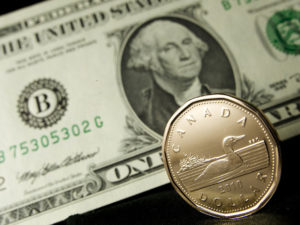 US dollar was trading with a slight change against its Canadian counterpart during the late phase of US trade on Friday, while the pair closed on negative territory, as markets were strongly influenced by concerns that the 16-day government shutdown in the United States could have probably led to a slow down in worlds largest economy.
US dollar was trading with a slight change against its Canadian counterpart during the late phase of US trade on Friday, while the pair closed on negative territory, as markets were strongly influenced by concerns that the 16-day government shutdown in the United States could have probably led to a slow down in worlds largest economy.
USD/CAD reached a session high at 1.0301 at 12:30 GMT, after which consolidation followed at 1.0288. The pair closed at 1.0292 on Friday, marking a 0.01% dip for the day. Support was likely to be found at September 30th low, 1.0275, while resistance was to be met at October 17th high, 1.0332.
On Friday a report showed that the annual Canadian index of consumer prices climbed 1.1% for a second month in a row in September, staying at the low end of the Bank of Canada’s target band, which is considered as providing price stability. Preliminary estimates were met. On a monthly basis, the index rose 0.2% in September, slightly above the projected 0.1% gain, after it remained flat a month ago. This result has been supported by higher costs of house accommodation services and food in the country. The core consumer price index (CPI), which excludes volatile components such as food and energy costs, also retained Augusts annual rate of increase in September, or 1.3%. The monthly performance of the core CPI showed a 0.2% gain in September, which was the equal pace of increase as that in August. Experts had expected a 0.3% climb in core consumer prices in September.
With the above mentioned data released, the Royal Bank of Canada would still probably retain its dovish stance. The central bank is forecast to maintain its benchmark interest rate target at 1% at the upcoming policy meeting on October 23rd. Banks Governor Stephen Poloz said last week that nations economic growth has “disappointed” and the economy was operating below the level the central bank expected six months ago. Bank of Canada projected in July that inflation rate will remain below banks target of 2% until the second quarter of 2015.
“With inflation so low and uncertainty in the U.S. economy, the economic metrics are just not showing enough growth for the Bank of Canada to start normalizing policy,” Jack Spitz, managing director of foreign exchange in Toronto at National Bank of Canada, said in a telephone interview, cited by Bloomberg News. “Until we see better economic releases domestically and the central bank takes a more hawkish approach any potential for the loonie to gain ground is remote.”
In addition, Canadian benchmark 10-year government bonds rose, as yields fell six basis points, or 0.06 percentage point, to reach 2.53%, marking their lowest level since August 12th.
Meanwhile, the confrontation over US fiscal policy, which shut the government down, “encouraged our enemies” and slowed economic growth, President Barack Obama said on October 17th. In a statement at the White House, after federal agencies started work for the first time since October 1st, Barack Obama also said that the United States suffers because of repeated fiscal brinkmanship, Bloomberg imparted.
Market players took a brief breath of relief on Thursday, following the news that the US Congress passed a bill to end the partial government shutdown and increase nations debt ceiling, but however, at present concerns arose that this 16-day period of shutdown may prompt the Federal Reserve Bank to postpone its intentions of paring back the monthly pace of its stimulus at least until the beginning of 2014. As a result, the greenback lost ground on a large scale. Before the shutdown in Washington global markets were expecting that the Federal Reserve will begin phasing out its asset purchases at its meeting on policy on October 30th, or in early December, though many experts have pushed back their estimates of a start date to early 2014, probably after current Fed Chairman Ben Bernankes mandate expires on January 31st.
Elsewhere, the loonie, as Canadian dollar is also nicknamed, closed slightly lower against the euro on Friday, with EUR/CAD cross up 0.05% on a daily basis to reach 1.4085. GBP/CAD pair closed the day at 1.6639, dipping a mere 0.01%. The Canadian dollar has depreciated 2.5% during this year against nine developed-nation currencies, which are tracked by the Bloomberg Correlation-Weighted Index. The US dollar, on the other hand, has gained 1.5% during the same period.





